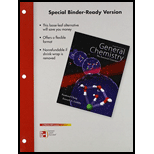
(a)
Interpretation:
The concentration of
Concept introduction:
Rate equation for the general reaction
The
The rate of the reaction is proportional to the concentration of B to the power of y is
Then the rate equation becomes,
Order of this reaction is the sum of the powers to which all reactant concentrations appearing in the rate law are raised.
(a)
Answer to Problem 14.23QP
The concentration of
Explanation of Solution
The given reaction is
The reaction follows second order kinetics.
Rate constant of the given reaction is
The concentration of
For a second order reaction the relationship between concentrations of reactant and time is,
Therefore, the concentration of
(b)
Interpretation:
The half-life when
Concept introduction:
Rate equation for the general reaction
The rate of the reaction is proportinal to the concentration of A to the power of x, is
The rate of the reaction is proportional to the concentration of B to the power of y is
Then the rate equation becomes,
Order of this reaction is the sum of the powers to which all reactant concentrations appearing in the rate law are raised.
Half-life is the time required for one half of a reactant to react.
Half-life for a second order reaction is
(b)
Answer to Problem 14.23QP
The half-life when
Explanation of Solution
The given reaction is
The reaction follows second order kinetics.
Rate constant of the given reaction is
The concentration of
We know that for a second order half-life reaction and half-life of a second order reaction is dependent on initial concentration
The half-life when
Want to see more full solutions like this?
Chapter 14 Solutions
Loose Leaf For General Chemistry With Connect Access Card
 ChemistryChemistryISBN:9781305957404Author:Steven S. Zumdahl, Susan A. Zumdahl, Donald J. DeCostePublisher:Cengage Learning
ChemistryChemistryISBN:9781305957404Author:Steven S. Zumdahl, Susan A. Zumdahl, Donald J. DeCostePublisher:Cengage Learning ChemistryChemistryISBN:9781259911156Author:Raymond Chang Dr., Jason Overby ProfessorPublisher:McGraw-Hill Education
ChemistryChemistryISBN:9781259911156Author:Raymond Chang Dr., Jason Overby ProfessorPublisher:McGraw-Hill Education Principles of Instrumental AnalysisChemistryISBN:9781305577213Author:Douglas A. Skoog, F. James Holler, Stanley R. CrouchPublisher:Cengage Learning
Principles of Instrumental AnalysisChemistryISBN:9781305577213Author:Douglas A. Skoog, F. James Holler, Stanley R. CrouchPublisher:Cengage Learning Organic ChemistryChemistryISBN:9780078021558Author:Janice Gorzynski Smith Dr.Publisher:McGraw-Hill Education
Organic ChemistryChemistryISBN:9780078021558Author:Janice Gorzynski Smith Dr.Publisher:McGraw-Hill Education Chemistry: Principles and ReactionsChemistryISBN:9781305079373Author:William L. Masterton, Cecile N. HurleyPublisher:Cengage Learning
Chemistry: Principles and ReactionsChemistryISBN:9781305079373Author:William L. Masterton, Cecile N. HurleyPublisher:Cengage Learning Elementary Principles of Chemical Processes, Bind...ChemistryISBN:9781118431221Author:Richard M. Felder, Ronald W. Rousseau, Lisa G. BullardPublisher:WILEY
Elementary Principles of Chemical Processes, Bind...ChemistryISBN:9781118431221Author:Richard M. Felder, Ronald W. Rousseau, Lisa G. BullardPublisher:WILEY





